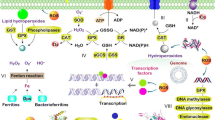Abstract
The content of sterols and lipids was compared in the cells ofSaccharomyces cerevisiae cultivated in sporulation and the sterol-induction nitrogen-limited media. After 24 h the measured values in the two cultivations did not significantly differ. However, after subsequent 24 h, further formation of lipid globules and a corresponding increase of lipid and sterol content was detected only in the sterol-induction medium. To demonstrate the similarity of physiological state during the first day of the two cultivations, the combined cultivations were performed. Maximum sporulation, suggesting maximum similarity, of the two processes was achieved when the cells were grown in the sterol-induction medium for 15 h and then transferred to a sporulation medium.
Similar content being viewed by others
Abbreviations
- IMM:
-
sterol-induction molasses medium
- RSM:
-
rich sporulation medium
- PSM:
-
poor sporulation medium
- OJ:
-
Olson-Johnson medium
References
Běhalov’a B., Votruba J., Pichov’a A., Beran K.: Fed-batch cultivation ofSaccharomyces cerevisiae with increased content of Δ5,7-sterols.Folia Microbiol. 31, 129–137 (1986).
Běhalov’a B., Voř’išek J.: Increased sterol formation inSaccharomyces cerevisiae. Analysis of cell components and ultrastructure of vacuoles.Folia Microbiol. 33, 292–297 (1988).
Chassang A., Roger M., Vezinhet F., Galzy P.: Variation of the lipid content of yeast cells during sporulation.Folia Microbiol. 17, 241–247 (1972).
Dickinson J.R.: The metabolism of sporulation in yeast.Microbiol. Sci. 5, 121–124 (1988).
Esposito M.S., Esposito R.E., Arnand M., Halvorson H.O.: Acetate utilization and macromolecular synthesis during sporulation of yeast.J. Bacteriol. 100, 180–186 (1969).
Freese E.B., Chu M.J., Freese E.: Initiation of yeast sporulation by partial carbon, nitrogen or phosphate deprivation.J. Bacteriol. 149, 840–851 (1982).
Fürst W.: Oxydationprodukte des Ergosterins. Einfluss von Extraktionbedingungen.Arch. Pharm. 300, 353–362 (1967).
Henry S.A., Halvorson H.V.: Lipid synthesis during sporulation ofSaccharomyces cerevisiae.J. Bacteriol. 114, 1158–1163 (1973).
Illingworth R.F., Rose A.H., Becket A.: Changes in the lipid composition and fine structure ofSaccharomyces cerevisiae during ascus formation.J. Bacteriol. 113, 373–386 (1973).
Jakubowski H.: Sporulation of the yeastSaccharomyces cerevisiae is accompanied by synthesis of adenosine 5-tetraphosphate and adenosine 5-pentaphosphate.Proc. Nat. Acad. Sci. USA 83, 2378–2382 (1986).
Morris D.L.: quantitative determination of carbohydrate with Dreywood’s anthrone reagent.Science 107, 254–255 (1948).
Olson B.H., Johnson M.J.: Factors producing high yeast yields in synthetic media.J. Bacteriol. 57, 235–246 (1949).
Press W.H., Flannery B.P., Tenkolsky S.A., Veterling W.T.:Numerical Recipes. The Art of Scientific Computing. Cambridge University Press, Cambridge-New York-New Rochelle-Melbourne-Sydney 1986.
Reynolds F.S.: The use of lead citrate at high pH, as an electron opaque stain in electron microscopy.J. Cell Biol. 17, 208–212 (1963).
Schmidt G., Thannhauser S.J.: A method for determination of desoxyribonucleic acid, ribonucleic acid and phosphoproteins in animal tissues.J. Biol. Chem. 161, 83–87 (1945).
Schoorl N., Regenbogen J.:Z. Untersuch. Lebensmitt. 57, 566 (1929); taken fromDav’idek et al.: Laboratory Handbook of Food Analysis, p. 240. (In Czech) Technical Literature Publishers, Prague 1977.
Shaw W.H.C., Jefferies J.P.: The determination of ergosterols in yeasts. IV. A short method based on ultraviolet absorption.Analyst 78, 509–514 (1953).
Ueki K., Sida Y., Tanje T.: Synchronization of sporulation in spheroplasts of yeastSaccharomyces cerevisiae.J. Gen. Appl. Microbiol. 27, 1–9 (1981).
Williams M.B., Rees H.D.: Colorimetric determination of ethylalcohol.Analyt. Chem. 22, 1556–1561 (1950).
Author information
Authors and Affiliations
Rights and permissions
About this article
Cite this article
Běhalov’a, B., Hoza, P., Bl’ahov’a, M. et al. Effect of nitrogen limitation and sporulation on sterol and lipid formation inSaccharomyces cerevisiae . Folia Microbiol 37, 442–449 (1992). https://doi.org/10.1007/BF02899903
Received:
Issue Date:
DOI: https://doi.org/10.1007/BF02899903




